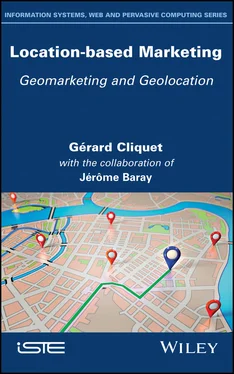1.4.2. Geomarketing techniques
Digital geography has developed considerably since the 1980s. The basis of this rapidly expanding discipline lies in the design and implementation within GIS organizations and tends to integrate methodologies from artificial intelligence such as multi-agent systems.
1.4.2.1. Geographic information systems, technical bases of geomarketing
A GIS is used to collect spatial data, store it, process it in map form, analyze it with known and available spatial analysis methods (Pornon 2015) and manage it so that it can be reused for other applications (Sleight 2004). GIS applies to many areas, including the following:
– public bodies (official institutes of statistics, of geography or of weather forecasts, the armed forces, etc.);
– public policies and in particular spatial planning, transport and telecommunications infrastructure management;
– business, to enable companies and organizations in general to manage transport and logistics networks and, more specifically, marketing.
GIS is used to collect, manage, combine and analyze spatial data for a specified region (Widaningrum 2015). A geographic information system is represented by several components:
– a geocoding system;
– a spatial database (Servigne and Libourel 2006) including elements of the geographical environment to map the studied region (cities, rivers, mountains, etc.);
– a database of the actors studied (consumers, companies, monuments, etc.);
– a mapping system that allows the maps to appear on the screen and be printed.
Mapping software is sometimes distinguished from GIS, which can render geographic information in a different form than the map. More generally, we talk about visual business intelligence. GIS often integrates spatial information processing tools (geostatistics, geodata mining, etc.). It has been possible to warn against the risk of conflict when implementing GIS, as the type of organizational structure must be taken into account (Pornon 1998). A more global concept was then proposed, that of a spatially referenced information system (SRS) (Servigne and Libourel 2006), because the installation of geospatial technologies is not neutral in organizations insofar as they can constitute a competitive advantage (Caron 2017).
All geomarketing work generally begins with a geographical breakdown of the area to be studied, composed of cells to define a domain of space that allows a continuous view (Servigne and Libourel 2006). This division requires a knowledge of the rules in this area. In France, the C ommission nationale de l'informatique et des libertés (CNIL) supervises work based on geographical breakdowns, as the breakdown cells must contain at least 2,000 inhabitants (such as the IRIS defined by INSEE, French national institute of statistics). Since 2016, municipal map collections at IRIS level have been available from the IGN ( Institut géographique national ) and since March 2018, it is also possible to download various INSEE geographical breakdown files:
– administrative breakdown: regions, departments, districts, etc.;
– breakdown of study areas: employment areas, urban areas, urban units, living areas, etc;
– intercommunality: the basis of EPCIs (Établissements publics commerciaux et industriels, state-owned commercial and industrial establishments) with their own taxation;
– municipal breakdown: table of geographical distribution of the municipalities;
– sub-municipal breakdown: IRIS (Îlots regroupés pour l’information statistique, grouped islands for statistical information), the equivalent of U.S. ZIP codes.
The division into IRIS is possible for all municipalities with more than 10,000 inhabitants and many municipalities with 5 to 10,000 inhabitants, which corresponds to 1,900 municipalities out of a total number of municipalities with more than 35,000: but everyone knows that the French State reduces this number each year in a very homeopathic way. Each IRIS is homogeneous from a habitat point of view. Indeed, the location of individuals’ housing responds to sociological imperatives and it can be seen that sociologically similar individuals tend to choose nearby dwellings (Filser 1994). There are a total of 15,500 IRISs. Each municipality with a population of less than 5,000 is considered an IRIS. INSEE also offers interactive maps with grids to “analyze the spatial distribution of georeferenced data in order to better understand the territorial dynamics at work in France”.
Maps are of course essential tools in geomarketing and they are now becoming more and more interactive, allowing decision makers to simulate situations. It has been shown that GIS-based geomarketing software can play a role in managers’ decision-making processes, especially in terms of location, because using such a tool saves time and therefore allows faster decisions with fewer errors (Crossland 1995). Such software can thus constitute a real decision support system. The integration of a GIS into a decision support system can help to solve the famous “last mile” problem (Scheibe et al . 2006). The grid applied by the INSEE, which breaks it down geographically into small cells, makes it possible to visualize certain characteristics in a very precise way (Fourquet 2019). This requires compliance with the constraints imposed by the CNIL (French national committee ensuring data privacy laws are adhered to) on the use of IRIS. This notion of geographical division will be used again when studying gravity models (see Chapter 4).
The choice of visualization tools, circles, bars or shadows, available in geomarketing software, is not totally neutral (Monmonier 2018). Indeed, their choice can influence the outcome of the decision (Ozimec et al . 2010). For example, the use of gradient circles is more justified when thematic maps are used, and is effective in decision making. The authors also explain that the use of these tools is independent of the personal characteristics of decision makers, such as the ability to manipulate maps and the experience they can provide. Using GIS does require cognitive skills, particularly with regard to map overlay (Albert and Golledge 1999).
GIS enables companies to increase their relational capital by systematically providing information on the location of their activities to their current or potential customers (Baños 2016). GIS are therefore no longer only marketing analysis tools, but are increasingly becoming a means of creating contact with customers through the use of the web; this is all the more true with the development of smartphones.
1.4.2.2. Some statistical tools for geomarketing
Marketing uses traditional statistical tools, like most other social science disciplines. Spatial marketing is no exception to this rule, but this discipline must submit to the specificities of spatial study, and adopt particular statistical tools; other disciplines such as spatial economics or anthropology also use these tools. As this book is not intended to develop sophisticated mathematical and statistical methods, it is nevertheless necessary to review a few tools in order to get the most out of the often tedious mapping work. It would be a pity to miss some conclusions because of a lack of knowledge of these tools. To do this, it is important to be familiar with spatial autocorrelation and related indices: Moran index, Geary index. Less specific to spatial analysis, however, the Gini coefficient (Gini 1921) is used in particular to show income inequalities by location as was done for the city of Athens (Panori and Psycharis 2018).
Autocorrelation expresses the correlation of a variable with itself. This correlation can be measured either over time by comparing successive values of the variable (temporal autocorrelation) or over time by measuring the variable in different locations (spatial autocorrelation) (Oliveau 2017).
Читать дальше












